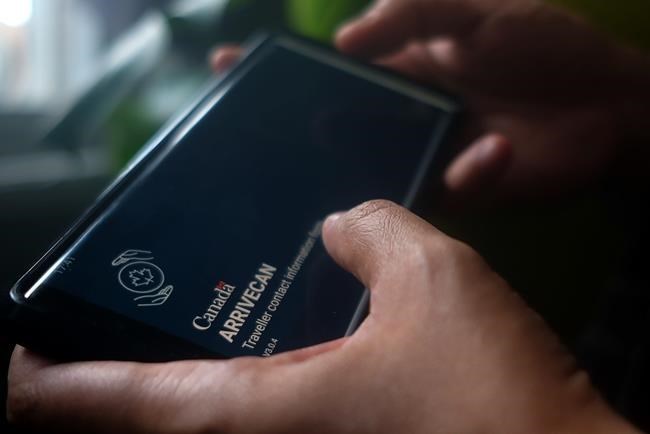OTTAWA — A failure of management, "glaring disregard" for policies, controls and transparency and dismal efforts to track spending drastically drove up the cost of the much-maligned ArriveCan app, the federal spending watchdog says.
The federal government launched the app in April 2020 as a way to track health and contact information for people entering Canada during the COVID-19 pandemic, and to digitize customs and immigration declarations.
It was met with frustration from travellers and the opposition Conservatives, who blamed the app for long waits at the airport and glitches that ordered fully vaccinated people to quarantine.
But all of that pales in comparison to the withering judgment Karen Hogan delivered Monday.
"This audit shows a glaring disregard for basic management and contracting practices throughout ArriveCan's development and implementation," the auditor general told a press conference.
The government's dependence on sole-sourced external contractors drove up the price of the app, and those costs weren't properly tracked, she noted.
Hogan estimated the app cost roughly $59.5 million, but the management of the project was so poor that it's impossible to know the final amount for sure.
The first ArriveCan contract was initially valued at just $2.35 million.
"This is probably some of the worst financial record-keeping that I've seen," said Hogan, who has been an auditor for several decades.
Even when it comes to other pandemic spending, the poor financial accountability has never been so flagrantly bad, she said — so bad, in fact, it's impossible to know whether documentation was destroyed or never existed in the first place.
"This software was developed during a global pandemic, a public-health emergency like Canada had not seen in a century," Public Safety Minister Dominic LeBlanc said in response to the report.
In the midst of the COVID emergency, the government relaxed some contract rules in an effort to expedite matters.
"We needed to act quickly to keep Canadians safe and adapt every process accordingly, but we recognize with hindsight that things should have clearly been done differently."
An emergency is no excuse for the rules to go out the window, the auditor chided.
Conservative Leader Pierre Poilievre wasted little time blaming Prime Minister Justin Trudeau for the debacle.
"He's taken 60 million of your tax dollars and given it to a corrupt app, 'ArriveScam,' that doesn't work, that we didn't need and that went 750 times over budget," Poilievre said.
Ultimately, the auditor found most of the problems with the app's development stemmed from the initial decision to rely on non-competitive contracts with external firms.
Those contracts were then extended and the cost of the work was increased over time.
The government failed to document initial discussions with contractors or the reason it didn't use a competitive process, Hogan said.
The Canada Border Services Agency, or CBSA, initially went with an external firm, GC Strategies, because it didn't have the resources and skills needed to do the work, the auditor said.
But it doesn't appear the agency made sure the contractors had the skills to do the work either.
When the CBSA did eventually move to a competitive process, GC Strategies helped write the narrow criteria for the contract.
"This gave GC Strategies an advantage that other potential bidders did not have," Hogan said.
The gaps the auditor identified are "unacceptable" and some of her recommendations have already been implemented, the agency said in a statement.
While she estimated the daily cost for each person working on the app is $1,090, the auditor said the equivalent cost would have been $675 if the work had been done in-house by government employees.
Hogan also noted that agency employees involved with ArriveCan were invited to dinners and "other activities" with vendors, including an online whisky tasting.
Her team didn't do a full audit of the dinners, but said the invitations went unreported and created a risk or perceptions of a conflict of interest.
The CBSA is looking into what happened, and referred part of the investigation to the RCMP.
Hogan also found little evidence the app was properly tested, which may have contributed to more than 10,000 people being ordered to quarantine for 14 days in 2022, even though they had provided proof of vaccination.
The app was introduced as a mandatory measure in the early days of the pandemic, when the government effectively closed the borders in an effort to stop the spread of COVID-19.
As the pandemic response evolved, so did the app. The auditor found ArriveCan was updated 177 times between its launch and when use of the app became voluntary in October 2022.
The government had no evidence the CBSA did the appropriate user testing on the 25 most substantial updates to the app to make sure it actually worked.
Only three updates appeared to have been fully tested and documented, which meant the agencies were "at risk of launching an application that might not work as intended," Hogan's report said.
There were some security tests done during pre-development by subcontractors, but some of the people doing the work did not have security clearance, which exposed the agency to an increased risk of security breaches, the report said.
The app no longer collects health information, but still exists as a paperless option for customs and immigration declarations for people who cross the border into Canada.
This report by The Canadian Press was first published Feb. 12, 2024.
Laura Osman, The Canadian Press

